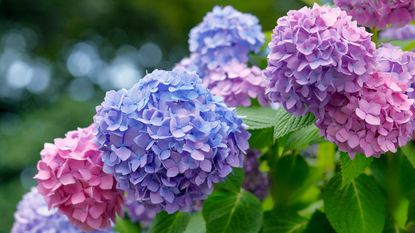

Learning how to care for hydrangeas is easy, so it's no wonder they're such popular plants. Of course, their huge blooms are a selling point, too, and make excellent cut flowers, both fresh and dried.
While these shrubs are low-maintenance, there are a few things to consider to keep them in their prime. Below, gardening experts reveal all the essentials, including advice on watering, soil type, and container plant care.
Whether growing in your borders or as beautiful outdoor potted plants, our pros' tips will help you enjoy a stunning hydrangea display year after year.
An expert guide on how to care for hydrangeas
A hydrangea can make an impressive addition to your whimsical garden plant ideas, and contemporary schemes alike — provided you look after them correctly. No drooping hydrangeas, burnt leaves, or insufficient soil here.
1. Choose your variety carefully

When it comes to choosing hydrangeas, you're spoilt for choice. There are compact varieties perfect for pots, climbing ones that clamber up walls, and larger shrubs ideal for improving garden privacy.
Different types offer different flowers. There are those with round, snow-white flowerheads ("Annabelle", available from Nature Hills, has been popular in recent years). Some have green blooms (try Hydrangea paniculata "Little Lime®", also from Nature Hills), while others have pretty pink or brilliant blue petals.
It pays to do your research, consider your options carefully, and pick one that's the right match for your space, needs, and climate.
For instance, Diane Kuthy, the founder of How To Grow Everything, shares that she's recently planted Hydrangea aborescens "Incrediball" (available at Nature Hills) to create a large, flowering hedge. They are easy to grow and don't need any special care in order to reliably bloom in her northern climate, she highlights.
2. Plant at the optimal time
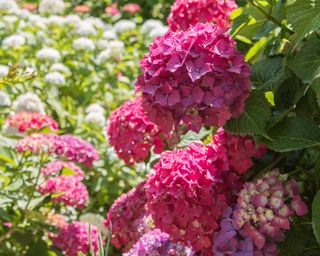
According to Anna Ohler, owner of Bright Lane Gardens nursery, you should plant hydrangeas either in the fall, or as a spring gardening job, when the weather is mild and the soil is workable.
She says, "Avoid planting during hot summer months or freezing winter conditions. If you live in a very hot region, planting in the fall is often a better choice to ensure your plant can receive enough water while establishing roots."
In climates with cold winters, Jessica Mercer of Plant Addicts recommends avoiding planting hydrangeas too early in the spring and risking a late frost, which could kill a newly planted hydrangea.
She says, "Similarly, in these areas, avoid planting hydrangeas close to the first expected hard freeze in late fall."
For gardeners in zone eight and above, planting can be done practically all winter, she adds as long as the soil is workable, Jessica advises.
Should you need a little more instruction about what gardening zone you're in, whether or not you're planning on growing hydrangeas, we delved into the basics of accessing the USDA Plant Hardiness Zone map and using it to bring your backyard ideas to life.
Considering zones will help you determine what you can plant as a perennial (regrows every spring) versus an annual (blooms for one growing season and dies off), the info is essential.
Choosing the right weather conditions and time of day for planting can also benefit your shrub. Nastya Vasylchyshyna, resident botany expert at Plantum, recommends planting in the morning, on overcast days.
"This way, you’ll avoid stressing the shrub with direct sunlight and excess heat," she says.
Growing your hydrangea as part of a container garden for a small space? The optimal planting time is the same as those destined for flower beds.
"If growing hydrangeas in pots, you have to be vigilant with the watering because the soil will dry out quite quickly," horticulturist Annette Hird, founder of Easy Urban Gardens, previously told Real Homes. "To ensure that your plants produce lovely large blooms consistently, feed them with a fertilizer that's high in potassium."
3. Provide enough space

It's always important to check your hydrangea's maturation size, as some varieties grow larger than others. For instance, Hydrangea macrophylla "Bailmer", available from Fast Growing Trees, can spread up to 6ft, while climbing hydrangeas can reach heights over 30ft.
A suitable planting space will make it easier to control in the long term, especially if you're working with a small garden. This will also improve air circulation around the plant which, Anna Ohler, owner of Bright Lane Gardens nursery points out, will help prevent fungal diseases.
If growing in pots, Jessica Mercer of Plant Addicts says the container must be large enough to accommodate the dense, fibrous roots. "The medium-sized varieties will need a pot with at least a 20-inch diameter."
Drainage holes are also important, she highlights, as Hydrangeas do not tolerate standing water.
Raised garden beds are good for drainage and suitable for certain hydrangea varieties, or a small number of hydrangea plants. The bottomless Veikous Galvanized Raised Garden Bed at The Home Depot is worth considering.
4. Plant in suitable soil
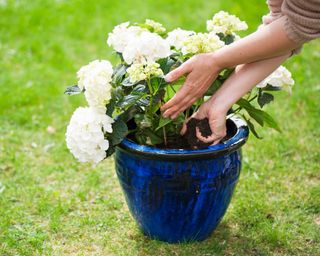
If planting hydrangeas in the ground, the ideal soil is a rich, well-drained loam, Jessica explains. "For sites with heavy clay or sand, work several inches of organic matter, like compost, into the soil."
If potting up, plant your hydrangea in a high-quality potting mix with plenty of organic matter and perlite for drainage, she adds. We recommend the organic perlite from Perfect Plants Nursery.
It's possible to change the flower color of varieties of Hydrangea macrophylla and Hydrangea serrata. The secret is in the pH of the soil: acidic soil will give you blue flowers, while alkaline or neutral conditions result in pink or reddish hues. You can buy suitable soil amendments online, such as Espoma's organic soil acidifier from Amazon.
"Keep in mind that using hard water can lead to the soil becoming more alkaline over time," says Nastya. Using water from a rain barrel will help keep your hydrangeas blue. Plus, it's a good way to save water — they're great for a more eco-friendly garden.
If you need a little help in this department, the Dr. Meter Soil Moisture Meter on Amazon is currently reduced. Considering the gadget has been purchased over 1,000 times over the past month, you can rest assured that it gets the job done.
If you want to get creative and learn how to use coffee grounds in gardening, Annette says it can result in fun floral colors.
"I've tried this out with my own plants by scattering some coffee grounds around the base of the soil around one of my plants," she says. "This has resulted in gorgeous blue blooms but it did take around a year for the results to be really noticeable. Acid soil will produce blue flowers while neutral to alkaline soil will result in pink flowers."
5. Get the right balance of sun and shade

Many types of hydrangeas, such as Hydrangea macrophylla and Hydrangea arborescens, are popular for shade gardens.
However, Jessica warns that too much shade may result in your plant not blooming well — if at all. So, you'll need to get the balance right for the best results. According to Jessica, the optimal positioning is typically on the east side of a house.
Georgia Clay of Monrovia adds, "We recommend areas with morning sun and afternoon shade. If you live in a very hot area of the country, they really need a break from the heat."
"Some varieties of Hydrangea paniculata can handle full sun. Be sure to read the tag to pick the right variety for your location."
When taking a look at locales for your florals, keep an eye out for petals with any browning. That is an indicator that they're receiving too much in the way of sunlight.
6. Water regularly

Watering correctly is crucial for happy and healthy garden borders.
Nastya Vasylchyshyna, resident botany expert at Plantum, says, "Hydrangeas are water-loving plants that benefit from consistent moisture. Proper watering helps them bloom longer and more profusely, as well as keeping foliage lush and healthy.
"It’s especially important to water young plants regularly for the first few months after planting so that they can build up a robust root system."
According to Georgia, a good rule of thumb is to water your hydrangea when the first inch of the soil feels dry to the touch. If you're unsure, or new to gardening, a moisture meter such as the XLUX Deep Soil Water Monitor available on Amazon.
Simply soak the ground around the hydrangea thoroughly with each watering, ensuring there is no standing water. Anna says, "If you do encounter standing water, you may need to replant the hydrangea with a better-draining soil mix. Skip watering on days that receive heavy rain."
A layer of mulch (Lowe's carry a wide selection of mulch) is a helpful addition to keep moisture in the soil on hot, sunny days, she adds. Anna also notes hydrangeas in containers will likely need more frequent watering than those in the ground. However, make sure you're not completely drenching the florals either, as that will have a negative impact on their health.
A large watering can, such as the Qilebi two-gallon watering can with long spout and stainless steel head from Amazon, is essential for this gardening task. Room Essentials' 2 Gallon Plastic Watering Can at Target is only $8.99 and a good budget buy.
7. Fertilize in the growing season

Hydrangeas in borders can benefit from feeding during the growing season, particularly if the soil is poor or your plant is showing signs of stress.
Miracle-Gro's Performance Organics Blooms fertilizer, available from Amazon, is designed to boost flowering plants and is well-rated. Be sure to follow the application instructions on the label for best results.
Feeding is especially important for hydrangeas in planters, as the nutrients from the original potting soil will deplete over time. Anna recommends repotting container-grown hydrangeas every two to three years to refresh the soil and prevent the plant from becoming root-bound.
Repotting isn't just for garden plants in containers, but it's a key part of caring for houseplants, too.
Meet our hydrangeas experts

Diane Kuthy is the founder and lead plant expert at How To Grow Everything, a collection of comprehensive grow guides for every plant and vegetable. Diane has over 10 years of gardening experience and she currently manages a five-acre farm, a four-season greenhouse, over 50 perennial fruit and vegetable varieties, and a large indoor plant conservatory.

Anna is an avid plant hobbyist and the owner and operator of Bright Lane Gardens, a boutique plant nursery in Northern Michigan. With over a decade of experience in gardening and landscaping, she takes every opportunity to share her knowledge on all things plant-related. She also runs the company's YouTube channel, which is full of practical advice.

Jessica Mercer, PhD, is the senior content marketing coordinator for Plant Addicts. As a plant collector, Jessica enjoys growing many different plants and learning about the best culture practices for each. Writing for Plant Addicts is a real joy for her, as she can use her science background to research interesting plant topics.

Annette Hird, the founder of Easy Urban Gardens, is a horticulturist and an urban gardening expert. She has worked as a professional propagator and managed, maintained, and improved many urban and rural gardens. She enjoys growing her own fruit, vegetables, herbs, and flowers as well as many different types of ornamental plants.

Nastya is a professional botany expert for the Plantum app that helps identify plants and plant diseases and provides care recommendations. Her specialization is plant morphology, phytopathology, and plant physiology.

In her role, Georgia works with breeders and plant finders from around the world to bring new plants to market for Monrovia. Georgia has worked in many different areas of the horticulture industry including retail, growing, and landscaping.
What to shop
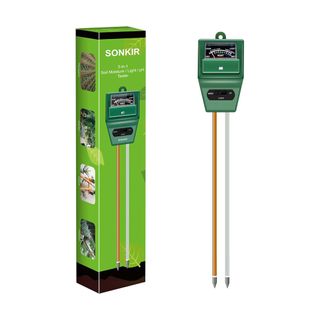
Price: $9.99
This is a useful tool if you're growing blue or pink hydrangeas, to help keep bloom color how you want it. What's more, it can measure sunlight and moisture, too.

Price: $8.95
A hand trowel is an essential for planting hydrangeas in pots, and this sturdy design with its carbon steel blade and ergonomic grip is a great option.
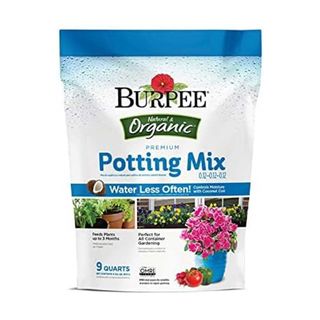
Price: $12.99
This popular soil blend from Burpee includes coconut coir, which helps to retain moisture. Plus, it will feed your plants for up to three months.
FAQs
How do you care for hydrangeas in winter?
Hydrangeas are hardy and if planted in the ground, they don't need much attention to get them winter-ready. Mulching in the fall, however, is beneficial for keeping the roots insulated and the soil moist.
Jessica recommends moving container-grown plants to a protected location over the winter, away from downspouts and areas with seasonal flooding.
"You may need to wrap the pots in burlap or horticultural fabric if winter weather is severe in your area," she adds. This is a good way to protect plants from frost.
What pests and diseases can be a problem for hydrangeas?
Nastya says, "Hydrangeas are susceptible to powdery mildew and leaf spotting. You can address these fungal infections by first pruning and incinerating affected shoots, then treating the shrub with a fungicide."
An example is Bonide's Captain Jack Copper Fungicide from Amazon, with over 6,000 five-star ratings.
Garden pest control is also important when caring for hydrangeas. Common interlopers include aphids, spider mites, slugs, and Japanese beetles, Jessica lists. They can rarely kill a plant, but they can leave it looking unsightly.
Aphids can be knocked off your hydrangea with a strong jet of water from a garden hose, Jessica advises. "If the infestation is large, you can spray the infected areas with insecticidal soap or neem oil."
The Garden Safe insecticidal soap from Amazon is a very popular pick and comes in a ready-to-use spray.
Spider mites prefer warm, dry conditions and tend to be drawn to drought-stressed plants. Jessica says, "To prevent these pests, keep your hydrangea well hydrated all growing season."
You can leave beer traps for slugs, or hand-pick them from the plant (wearing gardening gloves). Japanese beetles can also be removed by hand.
When should hydrangeas be cut back?
Hydrangeas should typically be cut back in late fall when flowering is all set for the season. Annette Hird, founder of Easy Urban Gardens says she cuts them back quite hard, taking each stem back to a set of leaf buds. When you prune, it might be a good moment to consider propagating your hydrangeas.
Looking for more planting advice? We've got practical guides on how to grow a rose garden and tips for growing lavender, too — both of which are beautiful cottage garden plants.
If you have your heart set on working with hydrangeas, we have an extensive guide for deadheading hydrangeas and pruning hydrangeas, which will definitely come in handy this season.
Join our newsletter
Get the best home decor ideas, DIY advice and project inspiration straight to your inbox!

The garden was always a big part of Holly's life growing up, as was the surrounding New Forest, UK, where she lived. Her appreciation for the great outdoors has only grown since then; over the years, she's been an allotment keeper, a professional gardener, and a botanical illustrator. Having worked for Gardeningetc.com for two years, Holly now regularly writes about plants and outdoor living for Homes & Gardens. In her spare time, Holly loves visiting local English gardens and is particularly fond of relaxed cottage-garden schemes. She also loves prairie-style planting – the tapestry effect of grasses mixed with drought-tolerant blooms never ceases to delight her. Always happiest around plants, when she isn't swooning over gardens, she's looking after her ever-growing collection of houseplants and arranging seasonal flowers in her apartment to paint.
- Danielle ValenteContent Editor